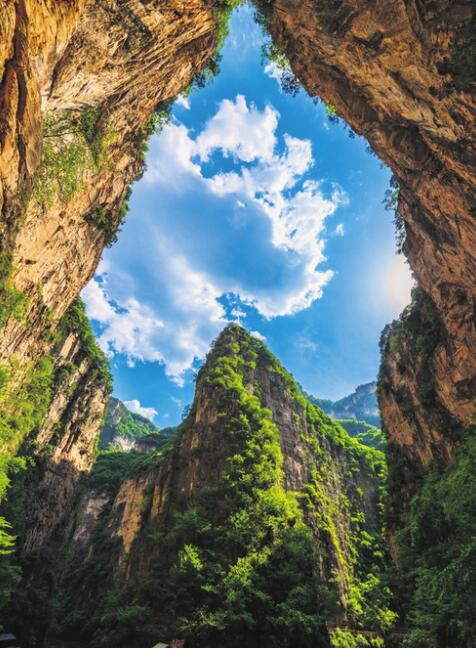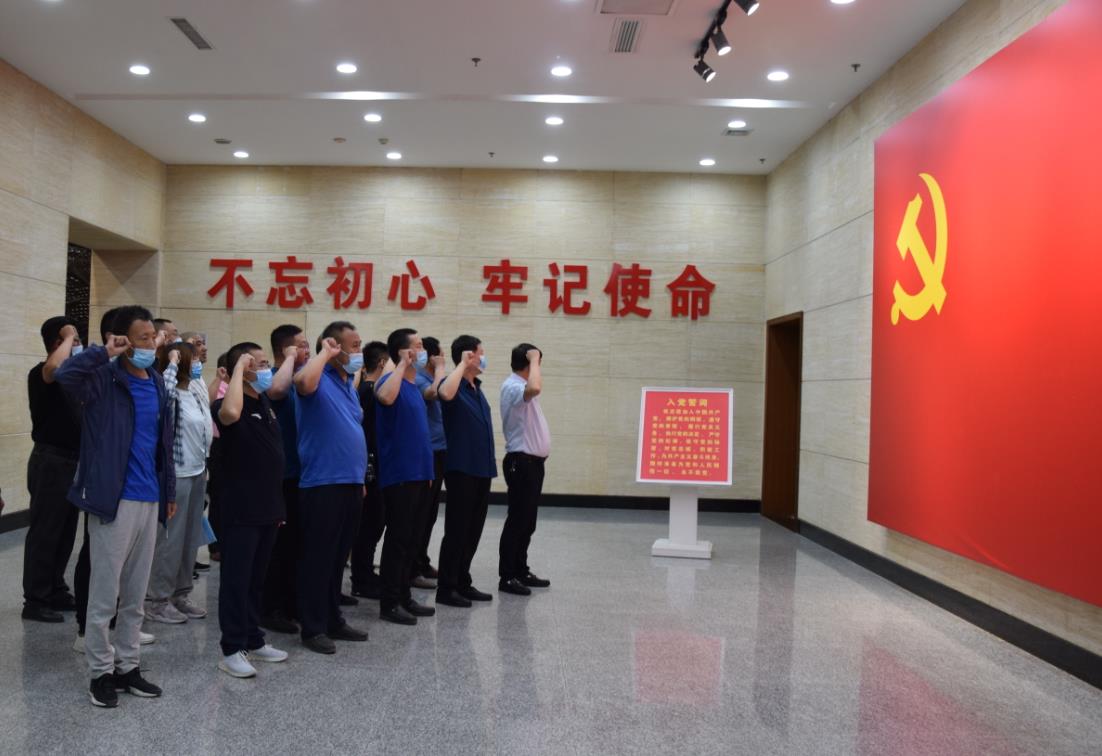
A heartshaped sky is viewed at the bottom of Baquan Valley. SANG XIAO / FOR CHINA DAILY
Baquan Valley
Located in Huguan county in the southern part of the Taihang Mountains, Baquan Valley became a 5A scenic area-the highest-rank destination rating by the national tourism authority-on Jan 8.
Baquan, which means eight springs, is so called because of eight springs that formed a torrential brook in the valley.
With a length of 13 kilometers and a width ranging from 3 to 20 meters, the narrow valley is surrounded by peaks rising up to 1,100 m from the valley floor.
In addition to dozens of waterfalls and several karst caves, the most impressive sight is the area called Yixiantian-which literally means one-line sky-in the narrowest part of the valley. It is so called because the sky is narrowed to a line seen from the bottom of the valley.
Niangziguan Great Wall
Niangziguan, which means "female general's pass", is located in Pingding county in the central part of Taihang. It is one of the strategic fortresses along the Great Wall.
The fortress is so called because it is said to have been built by Princess Pingyang during the early Tang Dynasty (618-907). Legends also have it that the first military force stationed there were an army of female warriors led by the princess.
The existing fortress and the Great Wall were built during the Ming Dynasty (1368-1644), with two gate towers and a 500-m wall still kept intact.
The Niangziguan Pass, controlling one of the important passageways between Hebei and Shanxi provinces, was a strategic stronghold in times of conflict and thus is a silent witness to many wars in history.
Huangcheng Xiangfu
Huangcheng Xiangfu, which literally means "imperial prime minister's residence", is located in Huangcheng village of Yangcheng county.
It was the residence of Chen Tingjing, a renowned prime minister during the Qing Dynasty (1644-1911).
Chen was the teacher of Emperor Kangxi and was the country's prime minister for about half a century.
As it offered accommodation to Kangxi when he visited Shanxi, the scale of the residence is among the largest of all officials' residences in China.
Covering 36,580 square meters, the complex has 16 courtyards and 640 rooms.
Impressive monuments and scenic spots in this tourist destination include an imposing stone archway with exquisite engravings, well-decorated rooms, classical gardens, an ancestral temple and a private school.
Mount Wutai
With its five flat-top peaks, Mount Wutai is a sacred Buddhist mountain located in Xinzhou city in northern Shanxi.
The cultural landscape is home to 41 Buddhist temples.
Among them is the Foguang Temple, with its eastern main hall being the longest surviving wooden structure in China. The hall was built during the late Tang Dynasty, with life-size clay statues.
Mount Wutai also features the Ming Dynasty Shuxiang Temple with a huge complex of 500 statues representing Buddhist stories woven into three-dimensional pictures.
Wutai is the holy mountain specially dedicated to Manjusri-the Bodhisattva of Wisdom. With temples built from the 1st century AD to the early 20th century, it has a far-reaching influence on China's Buddhism.
Mount Wutai is also the highest mountain in North China with its main peak standing 3,061 m above sea level.
By YUAN SHENGGAO
 山西路橋:黨建引領 建好“四好農村路”山西路橋建設集團黨委扎實開展“黨建質量提升年”,實施“六大工程”,立足“十四五”高質量、高速度、高效益發展的戰略基點,全面提高黨建質量和黨建引領發展水平,為打造“國內一流的交通基礎設施投資、建設、施工現代化企業集團”提供堅強政治保障。
山西路橋:黨建引領 建好“四好農村路”山西路橋建設集團黨委扎實開展“黨建質量提升年”,實施“六大工程”,立足“十四五”高質量、高速度、高效益發展的戰略基點,全面提高黨建質量和黨建引領發展水平,為打造“國內一流的交通基礎設施投資、建設、施工現代化企業集團”提供堅強政治保障。
 常住人口3491萬 山西人口普查數據"出爐"山西省統計局向社會通報山西省第七次全國人口普查主要數據。數據顯示,山西省常住人口為34915616人,比2010年(第六次全國人口普查數據,下同)減少2.23%,年平均減少0.23%。山西省常住人口總量減少,主要受人口流動變化等因素影響。
常住人口3491萬 山西人口普查數據"出爐"山西省統計局向社會通報山西省第七次全國人口普查主要數據。數據顯示,山西省常住人口為34915616人,比2010年(第六次全國人口普查數據,下同)減少2.23%,年平均減少0.23%。山西省常住人口總量減少,主要受人口流動變化等因素影響。